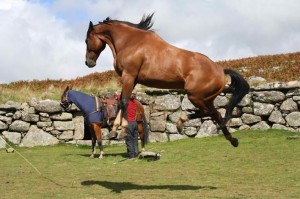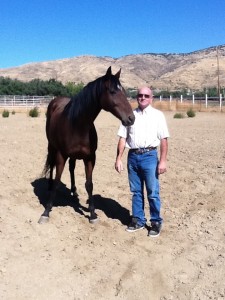Author’s note: This story was originally published on Jan. 6, 2012
Before Steven Spielberg’s movie lens created a cinematic star out of a rearing, wild-looking ex-racehorse named Finders Key, the petite bay was a bit—well— forgettable.
Even to the well-trained eye of owner and trainer Bobby Lovgren, his talent was initially a bit hard to spot.
“I didn’t recognize his potential for quite some time,” says Lovgren in a telephone interview with Off-TrackThoroughbreds.com this week.
“I had him for approximately two or three months and really got to spend a lot of time with him,” before uncovering the powerhouse of emotion that could naturally explode from the little horse like a fine actor who conjures raw feelings in an instant.
By the time Finder came into his life, the horse master and head horse trainer for the new Spielberg film War Horse had already honed an unerring ability to spot leading horse material. After working with Finder on the movie Seabiscuit, Lovgren was confident in Finder’s ability to deliver for War Horse.
While the role was a great experience for Finder and Lovgren, most of the scenes did not fully reveal the way the horse could command a scene. In War Horse however, the very best of what Finder does—charging, rearing, and even playing the poignant scenes upon which the story turns—lights up the movie, and reveals the astounding movie-making talent of a failed racehorse.
Race name: Finders Key
Sire: Lindseys Roberto
Dam: Thru The Keyhole
Foal date: 1999But what he does best, similar to an actor who can emote, is explode. On cue, in small spaces, or while rollicking across open fields, Finder can look the part of the most uncontrollable beast.
“His look and personality is the most exceptional I’ve ever seen!” Lovgren says. “I’ve never worked with a horse like this. He has such an explosiveness, and this incredible ability to jump around and rear and look the part of a very wild horse, all in a confined space.”
This expressiveness, which Lovgren noticed while Finder played a scene in which an unruly Seabiscuit tears the shirt off a jockey’s back, is something the trainer has encouraged through a training technique called Liberty Training. In this way, Finder is allowed to work on movements he does naturally.
Without constraint of bridle or other tack, the horse and trainer work consistently on a range of moves that seem to come naturally to Finder. On cue, Finder rears, runs, lies down and acts injured, and free jumps.
Lovgren explains that through consistency and trust-building exercises, the horse was taught to understand what was being asked of him, without being manipulated to do anything that didn’t come naturally. “I don’t typically teach a horse too many things because it’s the things they do naturally that I want them to do” on cue, for the camera, he explains.
“I train by repetition. They are all creatures of habit,” he says. “In my training, whether it’s with jumping or something else, I go from point A to B by directing him where to go. The exercises build his confidence in me.”
The rewards have dazzled even this deeply experienced horse trainer, who has a laundry list of movie work and top-notch training to his credit.
Their work on War Horse is the single greatest achievement of his career, says Lovgren, and the film itself is an unprecedented achievement in the horse-movie genre.
“The thing about this film that makes it stand out from all the other horse films is that while some of the things in it have been done before, never has it all been done, like it is in this film,” he says. “When I first read the script, I said, ‘Wow!’ Everything you can imagine for how a horse film (should be) is achieved in War Horse.”
And no accident that of all the horses and breeds he might consider to play such a critical role, he chose a Thoroughbred.
“The Thoroughbred is my (fondest) choice of horse, for their athletic ability. I really enjoy working with them,” Lovgren says. And Finder in particular, who is one of 14 horses trained to play the character “Joey,” is exemplary in his work ethic.
“Finder is a horse who truly enjoys his job. Other horses may want to go back to their stalls after, but Finder loves to work,” he says.
Understanding the capacity ex-racehorse Thoroughbreds have to be successful after their racing days are over, is something Lovgren learned long ago, while growing up in Johannesburg, South Africa.
“My family has one of the largest show-jumping barns in South Africa and ex-racehorse Thoroughbreds were all they used,” Lovgren says. “They’re awesome. They’re one of my highest (regarded) breeds.”
Equestrian International South Africa, his family’s facility, was teaming with glistening, talented ex-racehorse Thoroughbreds when Lovgren came to the US to be a cinematic horse trainer. Memories of them, and a deep knowledge and appreciation for their talent informed his decision to work with Finder and include him in the biggest film he has ever worked on.
In return, Finder delivered a breathtaking performance of the character Joey.
Not only did the little horse help tell the story of World War I and the fate of War Horses, but the one-time track failure demonstrates to the world that ex-racehorses can be winners in second careers.
“I think the Thoroughbreds are great,” Lovgren says. “I wish there were more of them…” working in movies.





This one of our favorite movies. My daughter has a horse rescue, Silverings. She has all types of horses come to her that are abused,neglected and owner relinguished. Just rescued 6 race horses from abuse/neglect case. Got them back in good health and to good homes. I cry every time I watch “War Horse” when he gets tangled in the wire. We’ve received horses that have these types of injuries.
Hi Sue! I hope this reaches you – I just LOVE this story, never get tired of seeing them. Your stories are so inspiring, thank you for sharing this! 🙂